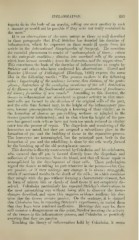Page 689 - My FlipBook
P. 689
INFLA HLVA TION. 699
ingesta do in the body of an amoeba, rolling one over another in such
a manner as Avould not be possible if they were not really contained in
the mass."
It is on observations of the same nature as those so well described
in these paragraphs that Prof. Strieker has founded his doctrine of
inflammation, which he expresses in these words (I quote from his
article in the Lifernational Encyclopcedia of Surgery). He considers
the essential phenomena to consist of " metamorphosis of tissue ; return
to the eitihryonie condition; division into amoeboid cells of the masses
which have become movable ; hence the destruction cind the suppuration."
This constitutes the basis of the doctrine of inflammation as taught by
Strieker and otliers who have confirmed his observations. Cornil and
Ranvier {Manucd of Pathological Histology, 1880) express the same
idea in the following words : " The process evolves in the following
order : hyjjertrophy of the nucleus ; increase, then division, of the jiroto-
plasin ; destrudion of the envelojjing membrane of the cell ; destruction
of the fibrous or of the fundamental substance ; production of fundamen-
tal tissue; formcdion of new vessels." According to this doctrine, the
tissues in inflammation are stimulated to greater activity in that amoe-
boid cells are formed by the division of the original cells of the part,
and the cells thus formed may, in the height of the inflammatory pro-
cess, become pus-corpuscles through a lowering of their vitality, as in
the formation of abscess on pus-yielding surfaces or mingled in the
tissues (purulent infiltration) ; and in that when the height of the pro-
cess has passed such cells as have not been too much reduced in vitality
enter into the process of repair. The diapedesis and wandering of the
leucocytes are noted, but they are assigned a subordinate place in the
formation of pus and the building of tissue in the reparative process.
Tlie leucocytes are intermingled, but the principal part, both in the
formation of pus and the rebuilding, is done by the cells newly formed
by the breaking up of the old protoplasmic masses.
This doctrine is directly controverted byCohnheim and his colaborers,
who contend that all pus is formed directly from the diapedesis and
collect ion of the leucocytes from the blood, and that all tissue repair is
accomplished by the development of these cells. These pathologists
regard the tissues as taking no part whatever in the process—that they
are passive, or if they undergo any change it is always retrograde,
wdiich if continued results,in the death of the cells; in which condition
they mingle with the pus without forming a characteristic element, but
in form of minute bits or shreds of dead tissue if not completely dis-
solved. Cohnheim particularly has repeated Strieker's observations in
the most painstaking way without being able to discover the tissue-
changes described, and upon this negative evidence reaffirms his doc-
trine that the tissues remain passive. On the contrary, it is claimed
that Cohnheim has, in repeating Strieker's experiments, so varied them
that they have been rendered ineffective. However this may be, there
still remains a disagreement on this point, Strieker asserting the activity
of the tissues in the inflammatory process, and Cohnheim as positively
asserting that they are passive.
Touching the theory of inflammation held by Cohnheim, it seems


